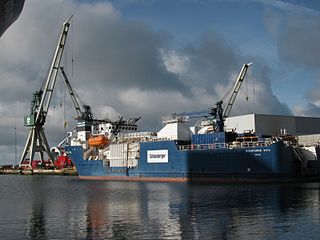Related Research Articles

An oil well is a drillhole boring in Earth that is designed to bring petroleum oil hydrocarbons to the surface. Usually some natural gas is released as associated petroleum gas along with the oil. A well that is designed to produce only gas may be termed a gas well. Wells are created by drilling down into an oil or gas reserve that is then mounted with an extraction device such as a pumpjack which allows extraction from the reserve. Creating the wells can be an expensive process, costing at least hundreds of thousands of dollars, and costing much more when in hard to reach areas, e.g., when creating offshore oil platforms. The process of modern drilling for wells first started in the 19th century, but was made more efficient with advances to oil drilling rigs during the 20th century.

A submersible pump is a device which has a hermetically sealed motor close-coupled to the pump body. The whole assembly is submerged in the fluid to be pumped. The main advantage of this type of pump is that it prevents pump cavitation, a problem associated with a high elevation difference between the pump and the fluid surface. Submersible pumps push fluid to the surface, rather than jet pumps, which create a vacuum and rely upon atmospheric pressure. Submersibles use pressurized fluid from the surface to drive a hydraulic motor downhole, rather than an electric motor, and are used in heavy oil applications with heated water as the motive fluid.

Coalbed methane, coalbed gas, or coal seam gas (CSG) is a form of natural gas extracted from coal beds. In recent decades it has become an important source of energy in United States, Canada, Australia, and other countries.

Directional drilling is the practice of drilling non-vertical bores. It can be broken down into four main groups: oilfield directional drilling, utility installation directional drilling, directional boring, and surface in seam (SIS), which horizontally intersects a vertical bore target to extract coal bed methane.

A drillship is a merchant vessel designed for use in exploratory offshore drilling of new oil and gas wells or for scientific drilling purposes. In recent years the vessels have been used in deepwater and ultra-deepwater applications, equipped with the latest and most advanced dynamic positioning systems.

NOV Inc., formerly National Oilwell Varco, is an American multinational corporation based in Houston, Texas. It is a worldwide provider of equipment and components used in oil and gas drilling and production operations, oilfield services, and supply chain integration services to the upstream oil and gas industry. The company conducts operations in more than 500 locations across six continents, operating through three reporting segments: Rig Technologies, Wellbore Technologies, and Completion & Production Solutions.

Casing is a large diameter pipe that is assembled and inserted into a recently drilled section of a borehole. Similar to the bones of a spine protecting the spinal cord, casing is set inside the drilled borehole to protect and support the wellstream. The lower portion is typically held in place with cement. Deeper strings usually are not cemented all the way to the surface, so the weight of the pipe must be partially supported by a casing hanger in the wellhead.
Underground coal gasification (UCG) is an industrial process which converts coal into product gas. UCG is an in-situ gasification process, carried out in non-mined coal seams using injection of oxidants and steam. The product gas is brought to the surface through production wells drilled from the surface.
The annulus of an oil well or water well is any void between any piping, tubing or casing and the piping, tubing, or casing immediately surrounding it. It is named after the corresponding geometric concept. The presence of an annulus gives the ability to circulate fluid in the well, provided that excess drill cuttings have not accumulated in the annulus, preventing fluid movement and possibly sticking the pipe in the borehole.
Underbalanced drilling, or UBD, is a procedure used to drill oil and gas wells where the pressure in the wellbore is kept lower than the static pressure of the formation being drilled. As the well is being drilled, formation fluid flows into the wellbore and up to the surface. This is the opposite of the usual situation, where the wellbore is kept at a pressure above the formation to prevent formation fluid entering the well. In such a conventional "overbalanced" well, the invasion of fluid is considered a kick, and if the well is not shut-in it can lead to a blowout, a dangerous situation. In underbalanced drilling, however, there is a "rotating head" at the surface - essentially a seal that diverts produced fluids to a separator while allowing the drill string to continue rotating.

In the oil and gas industry, coiled tubing refers to a long metal pipe, normally 1 to 3.25 in in diameter which is supplied spooled on a large reel. It is used for interventions in oil and gas wells and sometimes as production tubing in depleted gas wells. Coiled tubing is often used to carry out operations similar to wirelining. The main benefits over wireline are the ability to pump chemicals through the coil and the ability to push it into the hole rather than relying on gravity. Pumping can be fairly self-contained, almost a closed system, since the tube is continuous instead of jointed pipe. For offshore operations, the 'footprint' for a coiled tubing operation is generally larger than a wireline spread, which can limit the number of installations where coiled tubing can be performed and make the operation more costly. A coiled tubing operation is normally performed through the drilling derrick on the oil platform, which is used to support the surface equipment, although on platforms with no drilling facilities a self-supporting tower can be used instead. For coiled tubing operations on sub-sea wells a mobile offshore drilling unit (MODU) e.g. semi-submersible, drillship etc. has to be utilized to support all the surface equipment and personnel, whereas wireline can be carried out from a smaller and cheaper intervention vessel. Onshore, they can be run using smaller service rigs, and for light operations a mobile self-contained coiled tubing rig can be used.

A well intervention, or well work, is any operation carried out on an oil or gas well during, or at the end of, its productive life that alters the state of the well or well geometry, provides well diagnostics, or manages the production of the well.

Well completion is the process of making a well ready for production after drilling operations. This principally involves preparing the bottom of the hole to the required specifications, running in the production tubing and its associated down hole tools as well as perforating and stimulating as required. Sometimes, the process of running in and cementing the casing is also included. After a well has been drilled, should the drilling fluids be removed, the well would eventually close in upon itself. Casing ensures that this will not happen while also protecting the wellstream from outside incumbents, like water or sand.

Well stimulation is a well intervention performed on an oil or gas well to increase production by improving the flow of hydrocarbons from the reservoir into the well bore. It may be done using a well stimulator structure or using off shore ships / drilling vessels, also known as "Well stimulation vessels".

A direct exchange (DX) geothermal heat pump is a type of ground source heat pump in which refrigerant circulates through copper tubing placed in the ground unlike other ground source heat pumps where refrigerant is restricted to the heat pump itself with a secondary loop in the ground filled with a mixture of water and anti-freeze.
Oilfield terminology refers to the jargon used by those working in fields within and related to the upstream segment of the petroleum industry. It includes words and phrases describing professions, equipment, and procedures specific to the industry. It may also include slang terms used by oilfield workers to describe the same.

Grup Servicii Petroliere is a Romanian company providing offshore integrated services for oil and gas industry. The company, established in 2004, is a member of UPETROM Group.
A coiled tubing truck is used to deploy continuous tubing into an oil or gas well. They are normally used for well cleanouts (both over balanced or jetvac underbalanced, plug pulling or drill outs, fishing, spotting of acid or cement, installation of umbilicals such as flatak, or instrument and camera runs in vertical or horizontal oil and gas wells.

The energy sector of Ohio consists of thousands of companies and cities representing the oil, natural gas, coal, solar, wind energy, fuel cell, biofuel, geothermal, hydroelectric, and other related industries. Oil and natural gas accounts for $3.1 billion annually in sales while ethanol generates $750 million. Toledo is a national hub in solar cell manufacturing, and the state has significant production of fuel cells. In 2008, the state led the country in alternative energy manufacturing according to Site Selection Magazine, while the natural gas industry has experienced growth due to the expansion of shale gas.
References
- ↑ Archived 2014-08-10 at the Wayback Machine , Learn About Coiled Tubing Drilling, AnTech, 2014, Retrieved 28 July 2014
- ↑ , Drilling Market Focus: Coiled Tubing Use Growing Faster than Drilling Industry, The Oil and Gas Journal, 19 Sept 2005, Retrieved 30 July 2014
- ↑ , Niobrara Wells Prove BHA for Coiled Tubing, Drilling Contractor, 15 Mar 2012, Retrieved 30 July 2014
- ↑ Archived 2015-04-30 at the Wayback Machine , Introduction to Coiled Tubing: Drilling Applications, ICoTA, Retrieved 29 July 2014
- ↑ "Coiled Tubing Directional Drilling - Bottomhole Assemblies | Schlumberger". Archived from the original on 2019-02-10. Retrieved 2019-02-10.